There are two basic types of Word 2010 users: Those who upgraded from Word 2007 and those who skipped from Word 2003 (or an earlier version) directly to 2010. These two groups are likely to have very different experiences in learning Word 2010.
That's because with its Office 2007 suite, Microsoft introduced a new interface that radically changed how users interact with common features and functions. The company's newest Office 2010 software keeps the 2007 interface, with a few notable changes. This means that former Word 2007 users will find a few small interface tweaks and a handful of very useful new features in Word 2010, while those who haven't used Word 2007 are likely to feel completely bewildered.
Share this story: IT folks, we hope you'll pass this guide on to your users to help them learn the Word 2010 ropes.
This Word 2010 cheat sheet can help both types of users, covering how to get around as well as how to take advantage of what's new. We've noted which sections of the story former Word 2007 users can skip over.
Get acclimated to the new Word
To help you find your way around Word 2010, here's a quick guided tour of the revamped interface; follow along using the screenshot below.
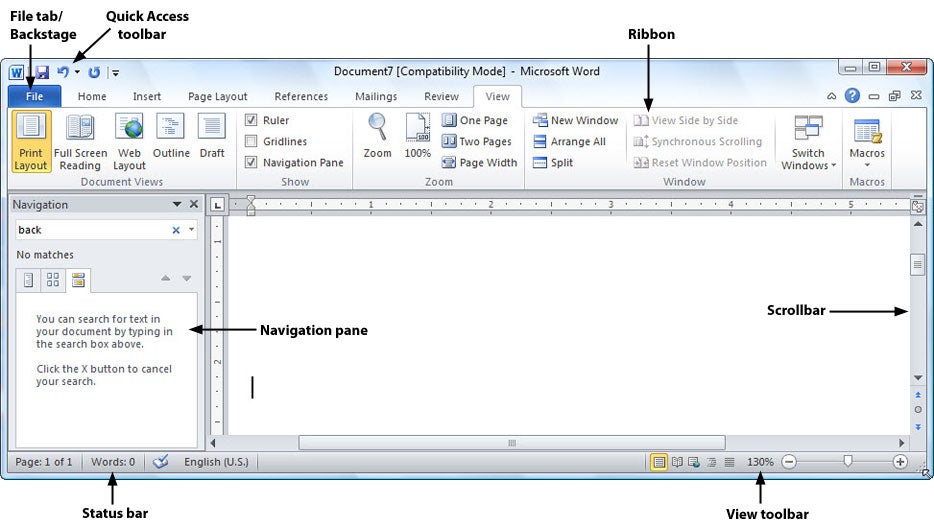 IDG
IDG
Get to know Word 2010's interface. (Click image to enlarge.)
The Quick Access toolbar. Introduced in Word 2007, this mini-toolbar offers buttons for the most commonly used commands, and you can customize it with whatever buttons you like, as we'll cover later.
The File tab/Backstage. The File tab in Word 2010 replaces the Office orb button in Word 2007, which replaced the old File menu found in earlier versions of Word. Click it, and it leads you to Backstage, a new command center where you can handle an array of tasks, including opening, printing and sharing files; customization; version control and more. As you'll see later in this story, Backstage represents the biggest change from Word 2007.
The Ribbon. Love it or hate it, the Ribbon is here to stay in Word. The Word 2010 Ribbon looks and works much the same as the Word 2007 Ribbon, with one nifty addition: In Word 2010 you can customize what's on the Ribbon.
The Navigation pane. This addition in Word 2010 lets you easily navigate around your document; it shows the document's organization by headings and lets you jump to any of them. It's also a search tool and can display thumbnails of all of the pages in the document. Normally, the Navigation pane is hidden; to display it, click the Find button that appears at the right edge of the Ribbon when you're on the Home tab, or press Ctrl-F when you're in any tab.
The Scrollbar. As in Word 2007, the scrollbar (for scrolling up and down in your document) has two minor extras: There's a small button at the top that looks like a minus sign that lets you split your screen in two, and just below that, there's a small icon that displays or hides a ruler when you click it.
The Status bar. As in Word 2007, the status bar displays information such as the number of pages and number of words in your document. If you highlight an area of text, it will display the number of words in the highlighted area.
The View toolbar. Here's another piece of the interface that looks and works like the one in Word 2007 -- and it's not much different from earlier versions. It lets you choose between print layout, full screen, Web layout, outline and draft views. There's also a slider that lets you zoom in or out on your document.
Learn to love the Ribbon
If you're comfortable with the Ribbon interface in Word 2007, you'll be happy to hear that it's basically the same in Word 2010. You can skip directly to the next section of the story, "Find your way around backstage," where you'll learn, among other things, how to customize the Ribbon -- a feature that wasn't available in Word 2007.
 IDG
IDG
The default Word 2010 Ribbon. (Click image to enlarge.)
At first, the Ribbon may be offputting, but the truth is, once you learn to use it, you'll find that it's far easier to use than the old Word 2003 interface. It does take some getting used to, though.
By default, the Ribbon is divided into eight tabs, with an optional ninth one (Developer). Here's a rundown of the tabs, with a description of what each one does:
File (also known as Backstage): As you'll see later in the story, here's where you perform a variety of tasks such as printing, sharing files, customizing the Ribbon and more.
Home: This contains the most-used Word features, such as tools for changing fonts and font attributes, customizing paragraphs, using styles, and finding and replacing text.
Insert: As you might guess, this one handles anything you might want to insert into a document, such as tables, pictures, charts, hyperlinks, bookmarks, headers and footers ... you get the idea.
Page Layout: Here's where you change margins and page size and orientation, set up columns, align objects, add effects and so on. There are some gray areas between this tab and the Home tab. For example, on the Page Layout tab you set paragraph spacing and indents, while on the Home tab you set paragraph alignment and spacing between lines.
References: This tab handles tables of contents, footnotes, bibliographies, indexes and similar material. It also lets you insert a "Table of Authorities," which sounds like something straight out of a Soviet bureaucracy but in fact is a list of references used in legal documents.
Mailings: As the name says, this is where you'll go for anything to do with mailings, from something as simple as creating labels to the more daunting task of mail merges.
Review: Need to check spelling and grammar, look up a word in a thesaurus, work in markup mode, review other people's markups or compare documents? This is the tab for you.
View: Here's where to go when you want to change the view in any way, including displaying a ruler and grid lines, zooming in and out, splitting a window in two and so on.
Developer: If you write code or create forms and applications for Word, this is your tab. It also handles macros, so power users might also want to visit here every once in a while.
The Developer tab is hidden by default. To display it, click the File tab and choose Options --> Customize Ribbon and then check the box next to Developer in the Customize the Ribbon section.
Each tab along the Ribbon is organized to make it easy to get your work done. As you can see below, each tab is organized into a series of groups that contain related commands for getting something done -- such as handling fonts, in our example. Inside each group is a set of what Microsoft calls command buttons, which carry out commands, display menus and so on; in the example, the featured command button changes the font size.
There's also a small diagonal arrow in the bottom right corner of some groups that Microsoft calls a dialog box launcher. Click it to display more options related to the group.
 IDG
IDG
Get to know how the Ribbon is organized.
All that seems simple enough ... so it's time to throw a curveball at you. The Ribbon is context-sensitive, changing according to what you're doing. Depending on the task you're engaged in, it sometimes adds more tabs and subtabs.
For example, when you insert and highlight a picture, an entirely new tab appears -- the Format tab, with a "Picture Tools" supertitle on top, as you can see here.
 IDG
IDG
The Picture Tools - Format tab appears only when you need it.
Other "now you see them, now you don't" tabs include Chart Tools, Table Tools and SmartArt Tools -- all of which appear in response to various actions you take in Word.
Find your way around Backstage
Backstage is an all-in-one stop for doing common tasks such as saving, printing and sharing documents, getting information about your documents, and more. It brings together a variety of functions that were found in multiple locations in previous versions of Word.
When you click the File tab on the Ribbon, you're sent to Backstage. The Ribbon disappears and is replaced by a series of items down the left-hand side of the screen, most of which are self-explanatory, such as Save, Save As, Open, Close, Recent, New, Print and Help.
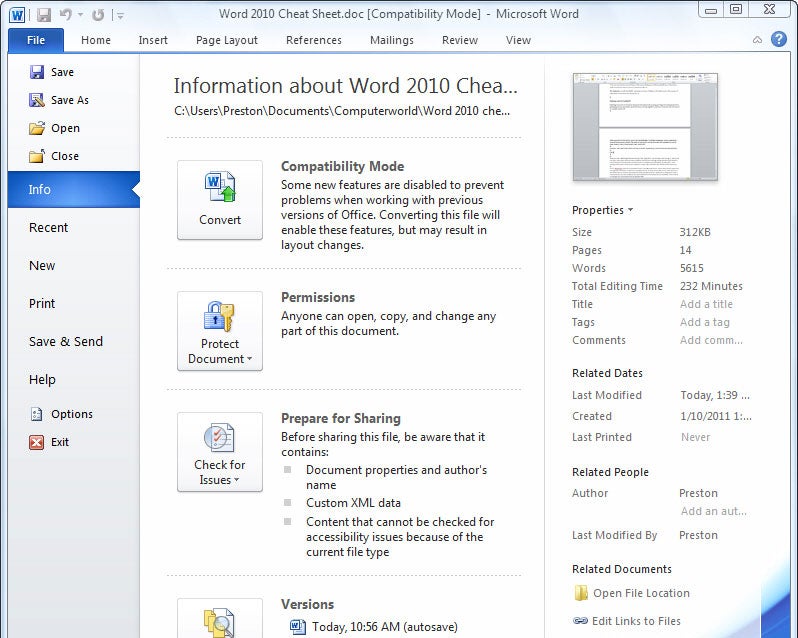 IDG
IDG
Backstage in Word 2010 is a one-stop shop for performing a wide variety of tasks. (Click image to enlarge.)
However, there are three choices that are not so self-explanatory, and can be enormously helpful:
Info
On the far right of the screen, Info shows useful information about the file you're working on, including its size, number of pages, number of words, the last time it was modified and printed, its author, the last person who modified it, the total amount of time spent editing the document, its title and tags, and similar information.
But finding information about the document is just the start of what you can do when you click the Info button. If you've opened a document that's not in the latest Word format (.docx), such as a .doc or .rtf file, you'll see a Compatibility Mode area, which lets you know that some of the newest Word features have been disabled to ensure compatibility with the older format. Click the Convert button if you want to convert the file into the new format, but note that some layout formatting may change.
Click Protect Document in the Permissions area to specify who has rights to read and edit the document, restrict all editing or set similar permissions options.
Before sharing the document with anyone, click Check for Issues in the Prepare for Sharing area -- this will enable you to see if you've left any hidden information or fields in the document, determine whether the file is compatible with earlier versions of Word, and see whether those with disabilities can read what is in the document.
Click Manage Versions in the Versions area if you would like to see earlier versions of the document that have been auto-saved.
Save & Send
Word 2010 was built for a world in which documents and their contents are meant to be shared in many ways, such as via email, in Microsoft's SharePoint collaboration software, in the cloud or in blog posts. Click Save & Send, and you get options to do all that and more.
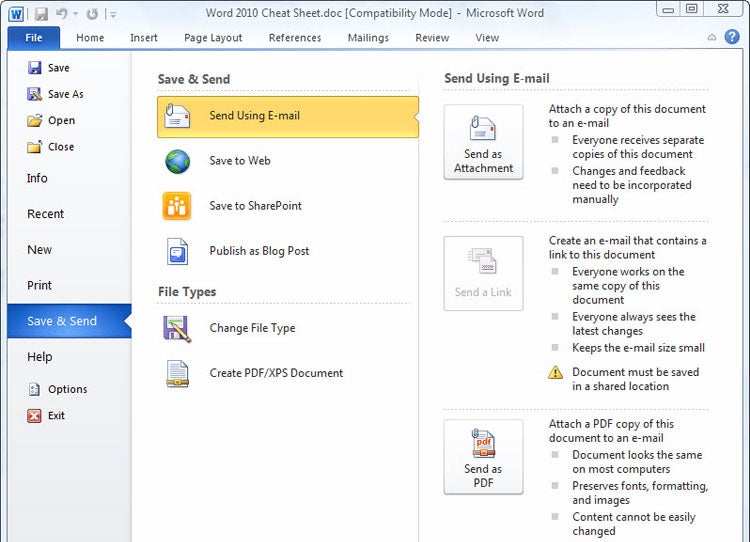 IDG
IDG
The Save & Send options in Backstage offer several ways to share your documents with others. (Click image to enlarge.)
Send Using Email attaches the current document to a blank outgoing email, using your default email program. You can send it in its current format, as a PDF or XPS (a PDF-like Microsoft format) file, or as an Internet fax. If the file is stored in a shared location, you can choose to email a link rather than an attachment.
Save to Web lets you save the file to Windows Live SkyDrive, Microsoft's cloud-based file storage site. You'll of course have to have a SkyDrive account, and you'll be prompted to log in the first time you use this feature. After that, when you click it, you can save the current file to any of your folders on SkyDrive.
Save to SharePoint lets you save your file to a SharePoint server for sharing with co-workers -- check your IT department if you don't have details for your organization's SharePoint access information.
Publish as Blog Post will publish the contents of your current document to any one of a variety of blogging sites including WordPress, Blogger, SharePoint, Windows Live Spaces, TypePad and Community Server. You'll of course need your blog log-in information. Depending on how your blog is set up, using this option can be very simple or so difficult that it's not worth the effort.
The Save & Send section of Backstage also lets you convert the file to a variety of other file types, such as plain text, .rtf, Open Document (.odt), PDF, XPS and others. Note that if you do this, you may lose some layout formatting.
Options
Here's where you can customize the way Word looks and works, taking care of everything from how text and formatting marks display, to what buttons appear in the Quick Access toolbar, to proofing options and more.
New to Word 2010 is the ability to customize the Ribbon. After you click Options, click Customize Ribbon, and you can choose what you want shown on each of the Ribbon's tabs.
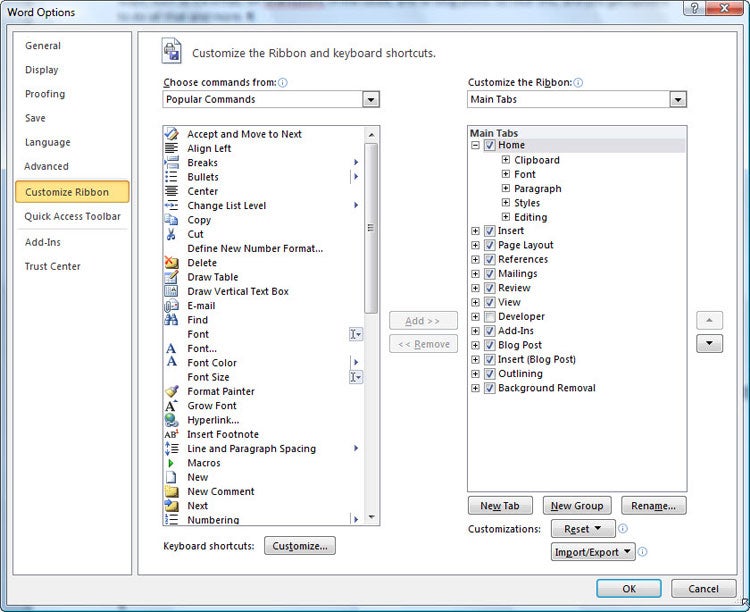 IDG
IDG
Options is where you can customize the way Word 2010 looks and feels to your heart's content. (Click image to enlarge.)
Use the new Navigation pane
The next biggest addition to Word 2010 is the new Navigation pane. It does triple duty:
• It lets you see the overall structure of a page, based on its headings, and then jump to any section.
• It shows thumbnails of each page so that you can quickly jump to any page.
• It's a search tool, showing you search results in context.
Launch the Navigation pane by pressing Ctrl-F or clicking the Find button at the right of the Home Ribbon. When the pane opens on the left side of the screen you'll see a search box at its top and three buttons beneath that.
Click the leftmost button and you'll see the structure of your document, based on its headings. Headings are collapsible and expandable in the same way they are in Windows Explorer, by clicking the tiny arrow to the left of the heading. To jump to any heading in the document, click it.
 IDG
IDG
Click the middle icon and you'll see thumbnails of all of your pages. Scroll through them until you find the page you want, then click the thumbnail to go right to that page.
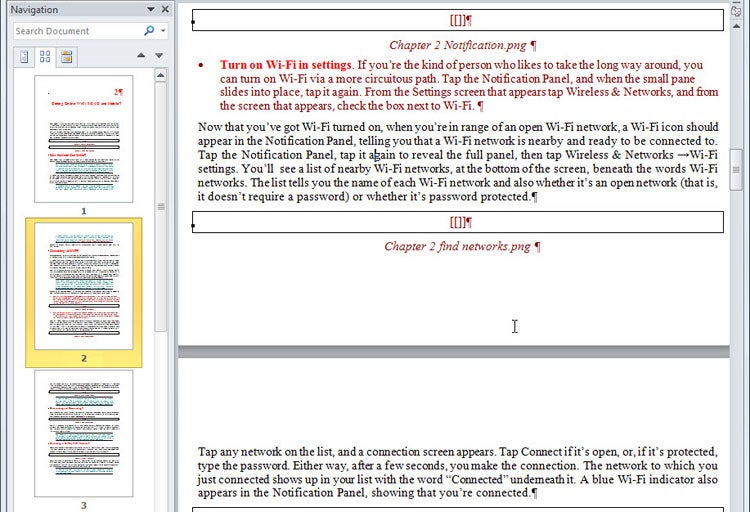 IDG
IDG
Click the rightmost icon and type in a search term at the top of the page; you'll see a list of all matching text in context so that you can view the surrounding text, with the text you're searching for highlighted in black. Click any result to jump to it.
 IDG
IDG
In Word 2010, when you search for a word or phrase, you also see surrounding text. (Click image to enlarge.)
You can also combine searching for text with the thumbnail and overall structure views of your document. In either of those views, type in text that you're looking for. Each instance of that text will then be highlighted in the main body of the document itself, although you won't see the text highlighting in the thumbnails or in the document structure view.
What if you want to not just search for text, but search and replace? Then you'll have to go the old-fashioned route. Click Replace to the right of the Ribbon on the Home tab, or press Ctrl-H from any tab. and you'll find Word's tried-and-true search-and-replace dialog box. Use it the same way you've used it in previous versions of Word.





